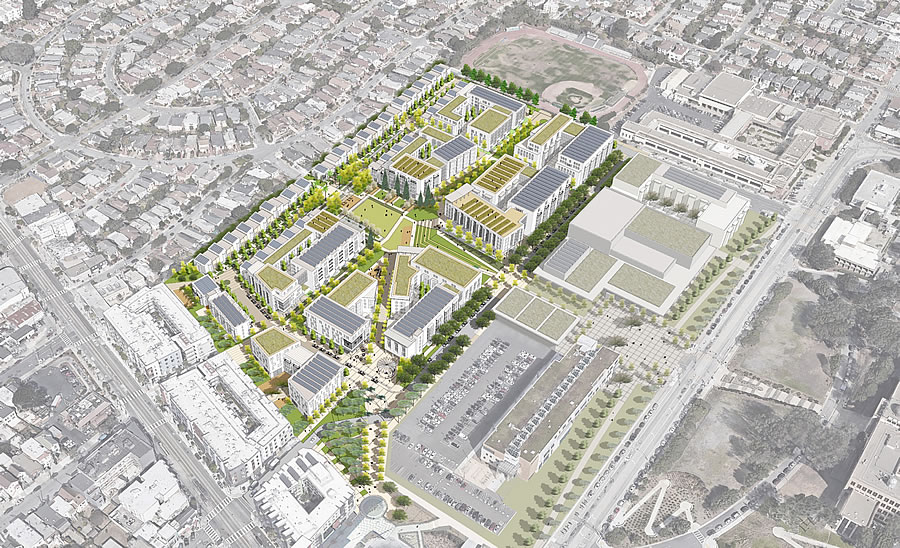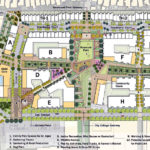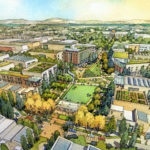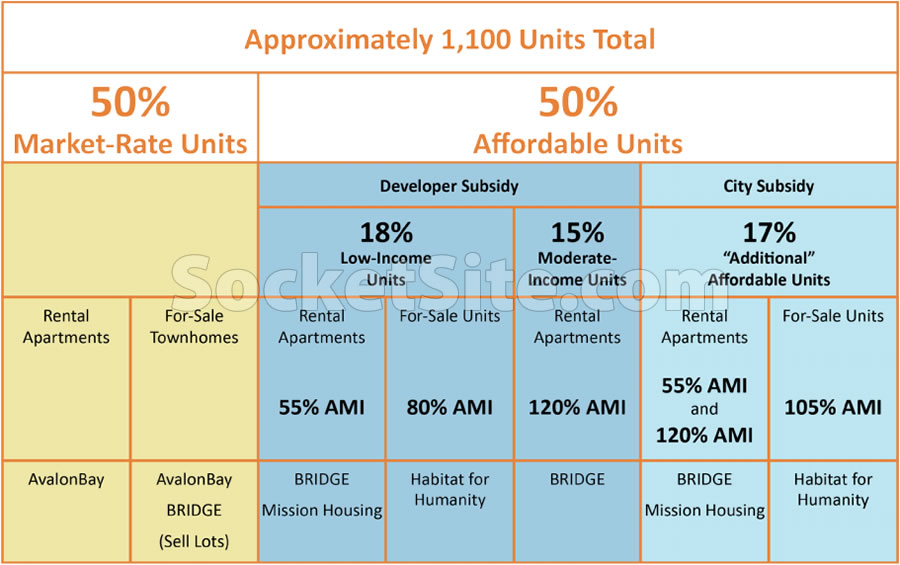As we first reported earlier this year:
According to a draft Fiscal Responsibility report for the massive Balboa Reservoir project, the projected $560 million development, a total which doesn’t include the price of the land or community benefits which have yet to be negotiated, could break ground “as early as 2021,” which is right in line with our original projection.
As such, the first wave of the development’s proposed 1,100-ish residential units could be ready for occupancy as early as 2023 with a second wave following two years later, “depending on market conditions.”
And of the 1,100-ish units, fifty (50) percent are slated to be offered at below market rates (i.e., “affordable”) to households with income limits ranging from 55 to 120 percent of the area median as broken down below:
The current Area Median Income (AMI) in San Francisco is around $81,000 for an individual and $92,000 for a household of two.
And once again, the current plans include off-street parking for over 1,000 cars with 500 spaces within a shared public garage, adjacent to CCSF’s proposed Performing Arts Center project.
With the preparation of a required Environmental Impact Report for the project about to get underway, the projected timeline has been refined. And while site prep, such as grading, excavation and infrastructure work, could commence in 2021, the first phase of building isn’t likely to commence before 2022, at the earliest, and be ready for occupancy in the second half of 2024, after which the building of Phase 2 could commence and would be ready for occupancy 30 months later.





So how much more do those 50% Market Rate people have to pay extra to subsidize the housing costs of the other 50% of the people at this Balboa Reservoir Redevelopment that are somehow entitled to drastic housing discounts?
That’s not how it works. You don’t pay $10k per month on a 2 bedroom unit just because an affordable 2 bedroom unit in the same building costs $2000 per month.
How do you think it works then?
Your willful ignorance is your own problem. Look at literally any building with a mix of market rate and affordable units; the pricing pattern doesn’t match what you blindly and delusionally seem to believe.
I really don’t appreciate your tone – I asked a simple question so you could elaborate on your statement. I deal in reality, not a dream world where laws can defy economical reality.
Stop voting in elected officials with redistributive wealth on their agenda, direct or hidden. Or don’t buy mixed use buildings in generally.
If I am in the market for housing, I want every bloody cent to go towards the construction materials, design, prime location, desirability among other buyers of my own socio-economic class. I don’t want my money going to paying off the line of elected officials like beggars on the street, another program to help the homeless or drug addicted, subsidy to those who earn less, etc.
This is how the City and the state has gotten into the housing mess– far too many uneducated and financially unsophisticated folks who head planning and development, coupled with complacent electorates who let things fall by the wayside for too long.
Collectively we seemed to be the epitome of the useless children of prosperous parents who let the family home fall into despair and ruin
Wow! Someone’s feeling a little Trumpublican. Do you really think only rich people should live in San Francisco? Ick.
My apologies if this is tongue-in-cheek….
“market rate” is determined by the market – not the developers pricing the units.
Affordable housing money comes from tax credits, government money, and a bit of developer profits. We don’t see developers going out of business and not making profits.
The market hasn’t proven itself good at making housing for people across income levels yet a healthy economy requires it since we need people at various income levels to do the diverse set of jobs that keeps our economy going. There are many things the market is not good at that requires government intervention. Capitalism is not a “set it and forget it” system.
The real problems are a lack of skilled workers driving up costs, stupid tariffs that are making building materials costs rise, and too many NIMBY’s
The subsidies are paid partly by the developer, and partly by the city, which is also providing the land. The market rate rents are set by the market– what people are paying in the area for similar units and what they are willing to pay to live to live here. The cost of building in SF, including subsidizing lower-rent units, and paying taxes, are indirect costs that may affect the amount of building generally, but does not directly set the market rent.
The timing of this project has been “refined” dozens of times over the last 20 years. It will never be built.
@ Outoftown: My understanding is the rent/price of the market rate units are set by the market.
Not wrong, but if you build a 100 unit building at a cost that requires $3,000 rent, but 30 of them have to be rented out at $2,000, you better hope the market is more than $3,430 with no vacancies – right? So if the given market is 3,300 then it doesn’t pencil and nothing gets build – whereas no affordable requirement would make it pencil… the builder/landlord has to recover their cost plus see a profit, or they will put their energy elsewhere.
So – while the affordable unit requirement will help some lucky people it will generally push the cost up of the remaining market rent apartments since it limits the supply of units. That being said, the words affordable and San Francisco don’t go together.
they should be able to get 3x as many units in there. its walking to BART and open land not being used. come on!
Really ?! At 1100 units/17acres > ~40,000 units/sq mi. > ~100,000 PEOPLE/SQ MI (emphasis added, and it’s conservative…1/2 million by ‘techie dorm’ standards) I think you’re confusing “should” with “could”.
So it dumps traffic on the neighborhood, while allowing no through streets in the new development?
Hmm. We need housing – but not sure we need gated communities.
Look at a map. Where are you going to connect through streets?
San Ramon Way
Brighton Avenue
Lee Avenue
None of those, save San Ramon, would qualify as a through street entering the development at one point and exiting elsewhere.That site has nowhere to send traffic other than to Phelan or Ocean, which is exactly what the rendering seems to show already.
That’s not how it works. Among other things, affordable housing developers get low income housing tax credits from the federal government which they typically sell to banks or other private equity. The other units don’t subsidize the affordable units, the government does.
There are some subsidies and tax credits available for low income housing, but they are limited! Just because a city decides that 20, 30 or 50% of new housing should be low income doesn’t mean that the tax-payer subsidies will be available.
Still waiting on you to provide some evidence that the inclusion of affordable units drives up market rate unit costs in the same complex beyond the normalized range of market rate for those units.
Reality is that somebody has to pay the piper. If I offer you $50 to install my ceiling fan but it cost you $60 to get to my house, are you going to take me up on my offer?
The affordable, inclusionary, BMR housing, by whatever name you call it, has to be paid for by somebody. If not by the occupants of those units, it will be the occupants of the remaining units or the tax payers if you go by mcva take.
You can be in favor of subsidized housing, but don’t pretend that nobody has to pay the subsidy. If you think it just magically reduces the cost of housing you should argue for 100% BMR housing to be applied to 100% of the housing stock.
if the development doesn’t pencil out, it will not get built and I’m sure SF policies will change. However, it and many other developments are getting built. SF is also doing pretty good at building considering the lack of building across the Bay Area in cities with fewer affordable housing requirements
Extend San Ramon Avenue to Phelan Avenue.
Extend Lee Avenue westward from Ocean Avenue to Judson.
Pretty basic stuff if you actually look at a map.
Every other neighborhood has streets – Why not this one?
Typical SF Beggar-Thy-Neighbor planning. Favor the few over the needs of the many.
“Extend Lee Avenue westward from Ocean Avenue to Judson”
This doesn’t make sense. Lee runs north-south and Judson is to the north and the extension of it is blocked off by Archbishop Riordan High School. Extending it north would make it dead end into the parking lot entrance road just south of the high school and immediately kick traffic right back onto Phelan.
Is it going to be a ground lease? Or a purchase. I believe Avalon is a ground lease but I could be wrong.
I would be all in for this if there weren’t so many parking spots. Cars are killing us.